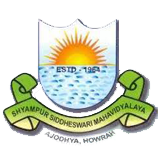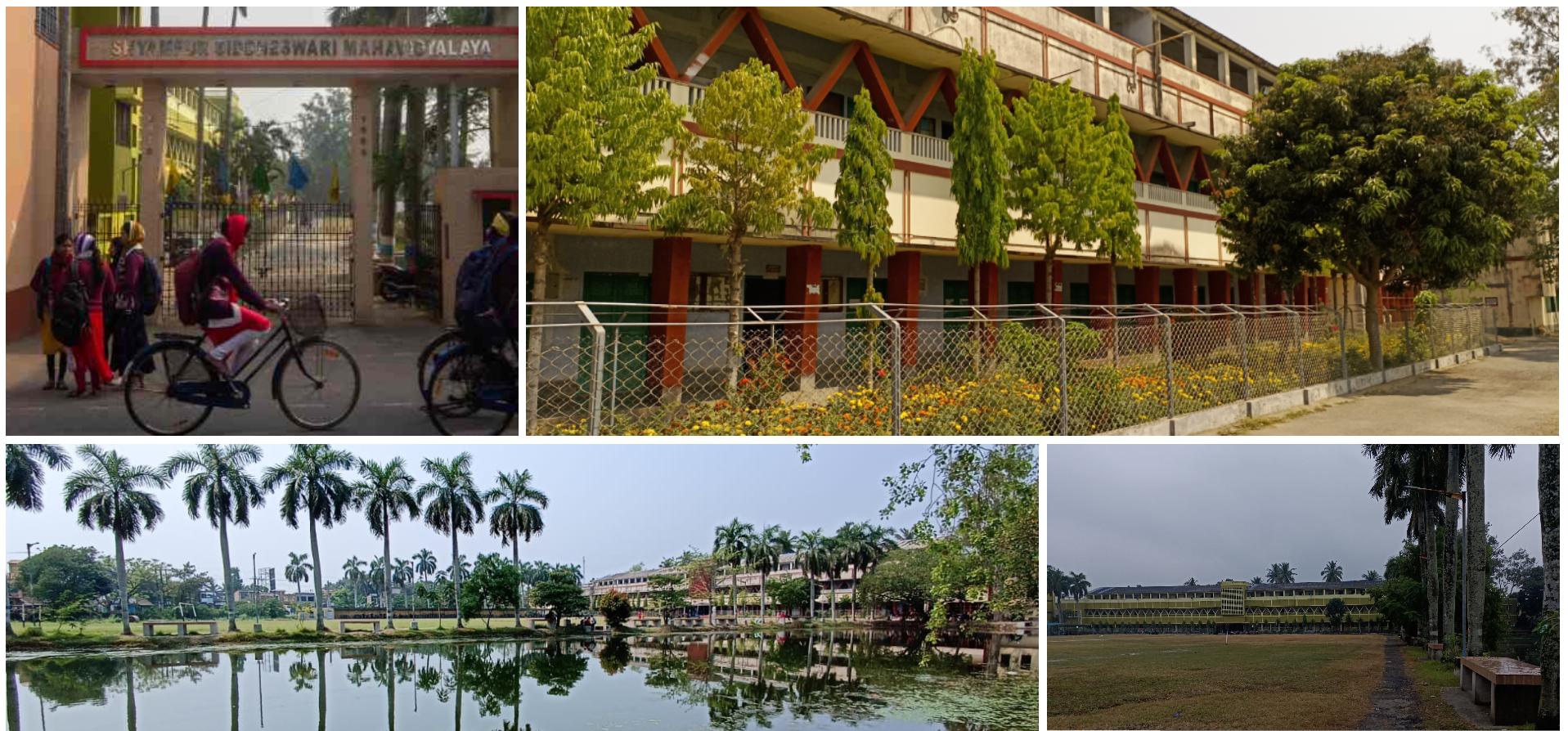
Shyampur Siddheswari Mahavidyalaya
Affiliated to Calcutta University
Institutional Digital Repository
Powered by National Digital Library of India (NDLI)


Communities in DSpace
Select a community to browse its collections.
Recent Submissions
চলচ্চিত্র উৎসব
(এই সময়, 2025-07-14) এই সময়
বেলপুকুর: হাওড়া গ্রামীণের শ্যামপুর সিদ্ধেশ্বরী কলেজে ছ'দিনের চলচ্চিত্র উৎসব শনিবার শুরু হয়েছে। কলেজে তৃতীয় বার এই উৎসব অনুষ্ঠিত হচ্ছে। শনিবারের উদ্বোধনী অনুষ্ঠানে উপস্থিত ছিলেন চলচ্চিত্র জগতের অভিনেতা অরুণ বন্দ্যোপাধ্যায়, পরিচালক রবি কিন্নাগী, ঋতব্রত ভট্টাচার্য, সুমন মুখোপাধ্যায়, বিশিষ্ট সমাজসেবী সোমনাথ মুখোপাধ্যায়।
হাওড়া গ্রামীণ জেলার কলেজ পেল ন্যাক-এর “এ” গ্রেড তকমা, খুশি পড়ুয়া-অধ্যাপকরা
(বর্তমান (Online), 2025-06-17) বর্তমান
উলুবেড়িয়া: শ্যামপুরের সিদ্ধেশ্বরী মহাবিদ্যালয় পেল ন্যাক-এর "এ" গ্রেড-এর তকমা। এই শিক্ষা প্রতিষ্ঠানে শিক্ষার গুণগত মান নিশ্চিত করার পাশাপাশি নেওয়া হয়েছে বেশ কিছু উদ্যোগ। যার মধ্যে রয়েছে প্রতিষ্ঠানের মান বজায় রাখা, উন্নত করা। এছাড়া শিক্ষার্থীদের জন্য উপযুক্ত শিক্ষার পরিবেশ তৈরি করা-সহ প্রতিষ্ঠানের সামগ্রিক উন্নতির দিক নির্দেশ। এই ধরণের একাধিক বিষয়ে সফলভাবে এগিয়ে নিয়ে যাওয়ার জন্য শ্যামপুরের সিদ্ধেশ্বরী মহাবিদ্যালয় পেয়েছে ন্যাশনাল অ্যাসেসমেন্ট অব অ্যাক্রিডিটেশন কাউন্সিলের বা ন্যাক-এর "এ" গ্রেড তকমা। এটিই হাওড়া গ্রামীণ জেলায় একমাত্র কলেজ যারা "এ" গ্রেড পেয়েছে। বর্তমানে এই কলেজের ছাত্র-ছাত্রীর সংখ্যা প্রায় ৪ হাজার। অপরদিকে, অধ্যাপক-অধ্যাপিকা এবং শিক্ষাকর্মী মিলিয়ে ১২০ জন এই কলেজে রয়েছেন। ছাত্র-ছাত্রীদের সুবিধার জন্য স্মার্ট ক্লাসরুম, ই-লাইব্রেরি, ওপেন এয়ার ক্লাসরুম এবং একাধিক বিভাগের ল্যাবরেটরি রয়েছে। কলেজ ক্যাম্পাসে কিচেন গার্ডেন, হার্বাল গার্ডেন, প্রজাপতি উদ্যানও তৈরী করা হয়েছে। এর পাশাপাশি কলেজে ইন্ডোর-আউটডোর গেম ছাড়াও রয়েছে যোগা সেন্টার এবং জিম সেন্টার। কলেজ "এ" গ্রেড তকমা পাওয়ায় খুশি ছাত্র-ছাত্রী এবং অধ্যাপক-অধ্যাপিকারা।
ন্যাকের এ গ্রেড পেল সিদ্ধেশ্বরী মহাবিদ্যালয়
(বর্তমান, 2025-06-19) বর্তমান
উলুবেড়িয়া: শিক্ষার গুণগত মান নিশ্চিত করা, শিক্ষার উপযুক্ত পরিবেশ তৈরি করা সহ একাধিক বিষয়ে উল্লেখযোগ্য দক্ষতা দেখিয়ে ন্যাক-এর বিচারে শ্যামপুরের সিদ্ধেশ্বরী মহাবিদ্যালয় 'এ' গ্রেড পেল। কলেজের প্রাপ্ত নম্বর ৩.০৫। সূত্রের খবর, হাওড়া গ্রামীণ জেলার মধ্যে একমাত্র শ্যামপুরের এই কলেজই ন্যাকের 'এ' গ্রেড পেয়েছে। কলেজে কীভাবে ছাত্রছাত্রীদের পড়ানো হচ্ছে, অত্যাধুনিক ক্লাস রুম আছে কি না, কলেজের পাঠ থেকে ছাত্রছাত্রীদের উপকার হচ্ছে কি না, প্রতিযোগিতামূলক পরীক্ষায় বসার জন্য পড়ুয়াদের প্রশিক্ষণ দেওয়া হচ্ছে কি না, সমাজে কলেজের কী অবদান আছে ইত্যাদি সাতটি বিষয়ের উপর কাজের ভিত্তিতে এই গ্রেড দেওয়া হয়। কলেজ সূত্রে খবর প্রায় ৬.৪২ একর সবুজ ক্যাম্পাসের এই কলেজে ছাত্রছাত্রীদের জন্য স্মার্ট ক্লাস রুম, একাধিক বিষয়ের পৃথক ল্যাবরেটরি, স্টাফ কোয়ার্টার্স, মেডিক্যাল রুম আছে। এছাড়াও কিচেন গার্ডেন, হার্বাল গার্ডেন, প্রজাপতি উদ্যান, ই লাইব্রেরি, অডিটরিয়ামও আছে। পাশাপাশি ইন্ডোর ও আউটডোর গেমস ছাড়াও ছাত্রছাত্রীদের জন্য যোগ ও জিম সেন্টার আছে। কলেজের অধ্যক্ষ ডঃ সব্যসাচী সেন জানান, কলেজের জন্য এটা নিঃসন্দেহে ভালো খবর। আগামী দিনে এ প্লাস গ্রেড পাওয়ার জন্য চেষ্টা করা হবে বলে জানান তিনি। এদিকে, এ গ্রেড পাওয়ায় খুশি কলেজের অধ্যাপক, অধ্যাপিকা সহ ছাত্রছাত্রীরা। বর্তমানে এই কলেজে ছাত্রছাত্রীর সংখ্যা চার হাজার এবং অধ্যাপক-অধ্যাপিকা ও শিক্ষাকর্মী নিয়ে মোট ১২০ জন আছেন।
ন্যাকের বিচারে এ গ্রেড পেল শ্যামপুর সিদ্ধেশ্বরী কলেজ
(এই সময়, 2025-06-20) এই সময়
এই সময়, শ্যামপুর:
শ্যামপুর সিদ্ধেশ্বরী মহাবিদ্যালয় ন্যাশনাল অ্যাসেসমেন্ট অ্যন্ড অ্যাক্রিডিটেশন কাউন্সিল বা ন্যাকের মূল্যায়নের বিচারে এ গ্রেড পেল। হাওড়া জেলার সরকার পোষিত কলেজগুলির মধ্যে গ্রামীণ এলাকার এই কলেজ এমন বিরল স্বীকৃতি পেল।
সূত্রের খবর, ন্যাকের পক্ষ থেকে কলেজগুলোর বিভিন্ন বিষয়ের কাজকর্ম খতিয়ে দেখার উদ্দেশ্যে গত এক বছর ধরে অনলাইন ও অফলাইন 'পরীক্ষা' হয়। সেই পরীক্ষার বিচারে এই মহাবিদ্যালয় এই সম্মান পেয়েছে। এর আগে ওই শিক্ষাপ্রতিষ্ঠান ২০১০ সালে ন্যাকের বিচারে বি গ্রেড পেয়েছিল। কিন্তু বি থেকে এ তে উত্তরণ রীতিমতো সাফল্য বলেই মনে করা হচ্ছে একটা গ্রামীণ কলেজের নিরিখে। শ্যামপুর থানার অনন্তপুরের বাসিন্দা বিশিষ্ট শিল্পপতি ও প্রয়াত বিধায়ক মুরারীমোহন মান্না বেলপুকুর এলাকায় শ্যামপুর সিদ্ধেশ্বরী মহাবিদ্যালয় প্রতিষ্ঠা করেছিলেন। সেই সময়ে স্বল্প সংখ্যক পড়ুয়াকে নিয়ে শুরু হওয়া এই প্রতিষ্ঠান আজ মহীরুহে পরিণত হয়েছে। বর্তমানে পড়ুয়ার সংখ্যা প্রায় পাঁচ হাজার। এই শিক্ষা প্রতিষ্ঠানটিতে ছাত্রীর সংখ্য প্রায় পঁচাশি শতাংশ। বর্তমানে ওই কলেজে মোট ১৪টি বিষয়ে স্নাতক-সহ ২১টি বিষয় আছে। কলেজের অধ্যক্ষ সব্যসাচী সেন বলেন, 'আমাদের এই শিক্ষা প্রতিষ্ঠানে ফ্লিপ মেথড, হাতেকলমে পড়াশোনার জন্য আধুনিক প্রযুক্তিকে অগ্রাধিকার দেওয়া হয়েছে। লেখাপড়ার পাশাপাশি খেলাধুলার জন্য কলেজের নিজস্ব জায়গায় ফুটবল, ক্রিকেট, বাস্কেটবল, খোখো, জিমনাসিয়ামের পৃথক ব্যবস্থাও আছে। এর পাশাপাশি কলেজের নিজস্ব পুকুর ও বাগানকে পড়ুয়াদের হাতেকলমে শিক্ষার কাজে ব্যবহার করা হয়। একটি প্রজাপতি উদ্যানও করা হয়েছে। এ ছাড়া ছাত্রছাত্রীদের অভাব-অভিযোগ শোনার জন্য কমপ্লেইন বক্সও রয়েছে।' ন্যাকের পক্ষ থেকে এই স্বীকৃতি পাওয়ার জন্য তিনি তাঁর সহকর্মী অধ্যাপক, অধ্যাপিকা এবং শিক্ষক কর্মচারী এবং পরিচালন কমিটির সদস্যদের সক্রিয় সহযোগিতার কথা স্বীকার করেন। এই বিষয়ে ওই কলেজের পরিচালনা সমিতির সদস্য ও ছাত্র সংসদের প্রাক্তন সাধারণ সম্পাদক, শ্যামপুর দু'নম্বর পঞ্চায়েত সমিতির সহকারী সভাপতি নদেবাসী জানা বলেন, 'আগে এই এলাকার পড়ুয়াদের উচ্চশিক্ষার জন্য অনেক দূর যেতে হতো। তাদের কথা চিন্তা করে ১৯৬৪ সালে বিশিষ্ট সমাজসেবী, প্রাক্তন বিধায়ক মুরারী মান্না মাত্র ২৫০ জন পড়ুয়াকে নিয়ে এই শিক্ষা প্রতিষ্ঠানের সূচনা করেছিলেন। মুরারী মান্নার দূরদৃষ্টির জলজ্যান্ত প্রমাণ আজকের এই কলেজ।'ওই কলেজ পরিচালনা কমিটির সভাপতি, শ্যামপুরের বিধায়ক কালীপদ মণ্ডল বলেন, 'সবার প্রত্যক্ষ ও পরোক্ষ সহযোগিতায় এই মহাবিদ্যালয় যে স্বীকৃতি পেয়েছে, তাতে আমরা গর্বিত।'
'এ গ্রেড' কলেজ
(আনন্দবাজার পত্রিকা, 2025-06-17) আনন্দবাজার পত্রিকা
শ্যামপুর: নাক (ন্যাশনাল অ্যাসেসমেন্ট অ্যান্ড অ্যাক্রিডিটেশন কাউন্সিল)-এর মূল্যায়নে 'এ গ্রেড' পেয়েছে শ্যামপুর সিদ্ধেশ্বরী মহাবিদ্যালয়। কয়েক মাস আগে এই কলেজে পরিদর্শনে আসে নাক-এর প্রতিনিধি দল। তারা কলেজের সব কিছু খুঁটিয়ে দেখে। সম্প্রতি তারা রিপোর্ট পাঠায়। তাতেই 'এ গ্রেড' পাওয়ার কথা বলা হয় বলে কলেজ কর্তৃপক্ষ জানান। কলেজের উন্নত মানের পঠনপাঠন, খেলার মাঠ, কর্মসংস্থানমুখী প্রশিক্ষণ ব্যবস্থা আছে। সেই সব কারণেই এই কলেজ নাক-এর ওই মূল্যায়ন পেয়েছে বলে কর্তৃপক্ষ জানান